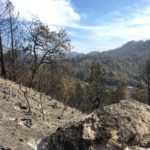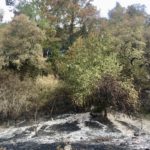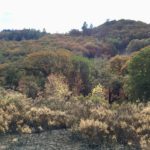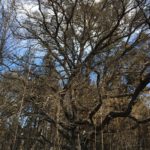October 27, 2020
Posted in: News Articles
Saddle Mountain and the effects of the Glass Fire
During the Glass Fire, which is now thankfully 100% contained, Saddle Mountain Open Space Preserve burned almost entirely. The Preserve is closed at present to volunteer patrollers as we assess and mitigate hazards so that community members can safely visit again. Our first priorities are to address bulldozer line and culvert repair, hazard trees along roads and trails, and the safe removal of the debris from the old hunting cabin structure that burned to prevent runoff of hazardous materials into nearby wetlands.
The fire’s effects across the Preserve were not as severe as we might have expected given the wind and fuel conditions. While we expect some significant Douglas fir mortality, particularly on the west side of the Alpine Creek drainage where topography aligned with the offshore winds, the fire moved across the vast majority of the Preserve as a ground fire, consuming surface fuels while not burning the forest canopy directly. Heat from a ground fire can still cause a lot of scorch to tree leaves and needles, but it was heartening to see that the trees themselves largely did not burn. Some areas, including the hardwood forests on Saddle Mountain proper and the oak woodland areas near Calistoga Road, show the kind of effects we would have looked for in a prescribed burn, with understory Douglas fir saplings killed and overstory hardwoods largely unscathed. The highest severity impacts are in vegetation communities where high-severity, stand-replacing fire behavior is typical, namely in the preserve’s chaparral and Sargent cypress stands; these impacts, while visually striking, are not concerning from an ecological standpoint.
As many of you know, since the Board approval of the Saddle Mountain Management Plan last fall we’ve been hard at work planning a series of fuel and vegetation treatments for the Preserve. These projects have included developing ecologically appropriate thinning prescriptions for shaded fuel breaks along roads and within overstocked portions of the Preserve’s forests (work we’d planned to implement this fall!), and planning and permitting for a series of prescribed burns for both grassland health and improved forest stand conditions, in partnership with Cal Fire, professional foresters, and other prescribed fire specialists.
The first of these burns were to have occurred this past spring, but fire agency resources were not available to plan and conduct the burns at that time; our next target had been late spring/early summer 2021. Naturally, the Glass Fire has shaken things up, but with some refinements all of these projects remain relevant and on track. Prescribed burning will most likely take a backseat to careful removal of dead saplings and ladder fuels in high-priority locations in the near future. As we saw when the Glass Fire crossed over into the Nuns Fire footprint, an area that has burned in recent years can still have plenty of available fuel, and there’s much we can do to try to ensure that the next fire is as gentle across the landscape as possible.
We will also be making use of this post-fire opportunity to conduct aggressive invasive plant removal in 2021 as well as botanical surveys to identify rare or unusual fire-following native plants on the Preserve. And if circumstances relating to the Covid-19 pandemic will allow for small, safely-distanced outdoor events in spring 2021, we hope to be able to offer outings at that time to enable community members to learn about fire ecology and fuel management planning on the Preserve and to experience firsthand the ecological effects of the Glass fire and the regeneration that a single rainy season can bring.
For more about the effects of the 2020 fires on protected lands, and for landowner resources see here >>



